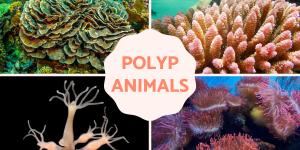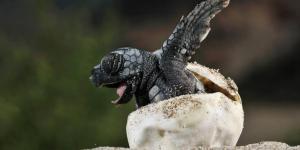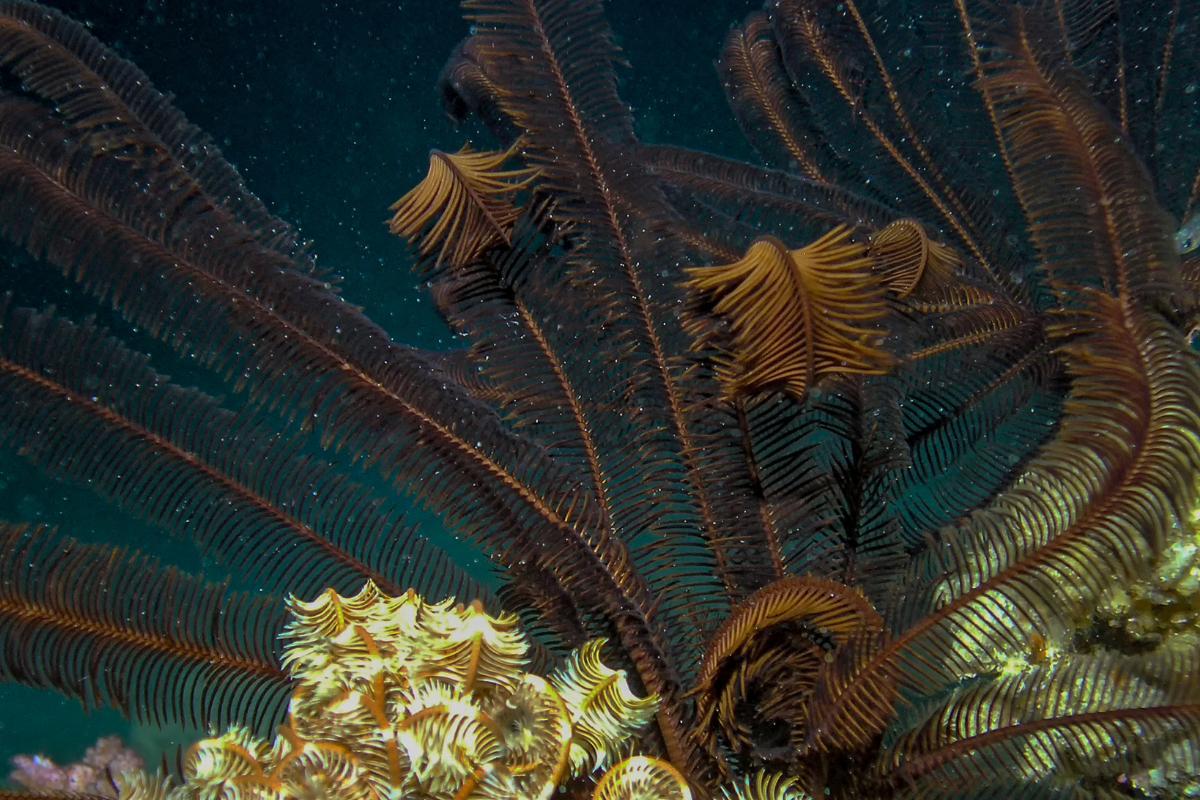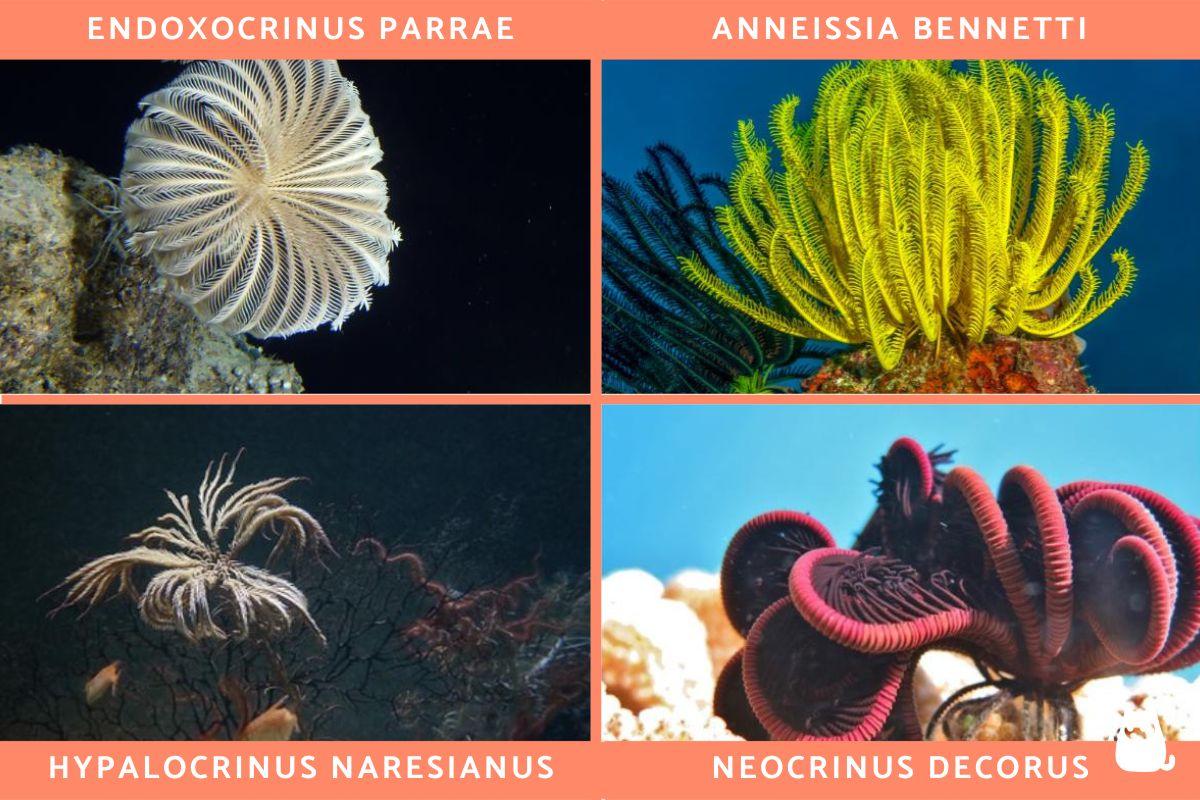Are Sea Lilies Animals?


Sea lilies (crinoids) are a group of marine animals with a surprisingly ancient lineage. Despite their plant-like appearance and name, these filter feeders are close relatives of starfish, sea urchins, and sea cucumbers, belonging to the echinoderm phylum. With a fossil record dating back 450 million years, sea lilies have not only endured mass extinction events but also thrived, evolving into a diverse array of shapes, sizes, and colors.
In this AnimalWised article, we will explore what sea lilies are, their main characteristics, classification, and examine some examples.
What are sea lilies?
Sea lilies, or crinoids, are echinoderms distinguished by their radial symmetry and a calcareous (calcium carbonate) skeleton composed of numerous interlocking plates. These marine invertebrates, despite their plant-like appearance, are filter feeders with specialized arms for capturing food particles.
Sea lilies first appeared in the fossil record during the Ordovician period, around 485 million years ago. This makes them one of the oldest groups of marine animals still in existence today.
Crinoids can be categorized into two main groups based on their lifestyle:
Sea lilies proper (Sessile Crinoids): these crinoids remain attached to the seabed throughout their adult lives using a stalk (peduncle). The stalk provides stability and allows them to exploit currents effectively for filter feeding. Their feathery arms, extending from a central cup-shaped body, create a large surface area for capturing plankton and organic detritus from the water column.
Feather Stars (Non-Sessile Crinoids): Unlike their sessile counterparts, feather stars lack a stalk and exhibit a mobile lifestyle. They utilize appendages called cirri for crawling along the seabed or swim by undulating their arms. This mobility allows them to actively search for food sources or escape predators.
Both sessile and non-sessile crinoids share the characteristic feather-like arms for feeding. However, their reliance on the stalk for attachment fundamentally shapes their ecological niche. Sessile crinoids are efficient filter feeders in current-rich environments, while feather stars exhibit greater flexibility in food acquisition and predator avoidance.
Intrigued by sea lilies? Don’t miss out on our comprehensive look at the diverse world of sea urchins.
Are sea lilies animals?
Sea lilies belong to the kingdom Animalia, which includes all animals. This kingdom is characterized by organisms that are multicellular, heterotrophic (obtain their food from external sources), and typically have specialized tissues and organs.
The classification of sea lilies and the crinoid group in general has evolved over time. Depending on the source, there may be some variations in the established taxonomy. However, there is general agreement that sea lilies are a type of echinoderm and belong to the class Crinoidea. This class is subdivided into crinoids with stems, known as sea lilies, and crinoids without stems, known as feather stars, indicating that both groups are related.
In response to phylogenetic studies and molecular analyses, one proposed classification for sea lilies is as follows:
- Kingdom: Animalia
- Phylum: Echinodermata
- Class: Crinoidea
- Subclass: Articulata
- Order: Bourgueticrinida
Other classifications include the order Isocrinida, which encompasses primitive sea lilies, and the order Millericrinida, which includes rare species known primarily from fossils.
Crinoids are an ancient group, with some species emerging after mass extinction events. As mentioned before, they have diversified into two major groups, which demonstrates their adaptability, as some species inhabit shallow waters while others live in considerable ocean depths.

Characteristics of sea lilies
Sea lilies have a unique body structure and lifestyle. Here's a breakdown of their key characteristics:
- Instead of arms, they have flexible, branching structures covered in finger-like extensions called pinnules. Cilia (tiny hairs) on the pinnules create currents to draw food particles.
- The central disc houses internal organs. It's covered in leathery tissue and protective calcareous plates.
- They possess an elongated stalk, made of interlocking plates, anchoring the sea lily to the seabed. Some species have cirri (appendages) for additional stability. Stalk length can vary, with some deep-sea crinoids reaching a meter.
- They use their arms and pinnules to capture tiny food particles from the water column.
- Their digestive system includes a mouth, esophagus, coiled intestine with pouches for nutrient absorption, and an anus near the mouth.
- They have a relatively simple sensory and nervous systems, with a nerve ring around the mouth and nerves extending into the arms. Some species have light-sensitive organs at the arm tips.
- They have a network of water channels for gas exchange and other vital processes.
- Most range from 15 to 30 cm, but extinct species were much larger.
- For support and protection, they have tiny calcium carbonate plates made of calcitic ossicles.
- They have separate sexes, with reproductive cells in the pinnules and arms. Fertilization is external, with larvae dispersing before settling on the seabed.
- Sessile (stalked) crinoids are stationary as adults, while feather stars (stalkless crinoids) can crawl or swim using cirri or arm undulations.
- Sea lilies have a rich fossil record, dating back to the Cambrian period.
- They were once much more abundant and formed vast underwater meadows.
- They have the ability to regrow mutilated body parts.
If you found sea lilies fascinating, you’ll love exploring the unique traits of sea spiders.

How do sea lilies reproduce?
Sea lilies, though capable of regenerating lost body parts due to predation or environmental damage, cannot reproduce asexually to create complete individuals.
Sea lilies are dioecious, meaning there are separate male and female individuals. The gonads are typically located on some pinnules and may also be present on the arms. Instead of ducts to expel sex cells, the release occurs through the rupture of the pinnule walls.
Once the gametes are released into the water, external fertilization occurs. Fertilized eggs may be retained in the sea lily's arms during development. After the embryo develops, a bilaterally symmetrical, free-swimming larva emerges. These larvae are microscopic and free-floating, drifting in currents and sometimes equipped with feeding structures to sustain themselves.
After a few days of swimming, the larvae settle on the seabed and undergo metamorphosis, transforming into a juvenile form resembling a young sea lily. These juveniles attach themselves to the seabed using a newly developed stalk or peduncle, in the case of stalked crinoids.
While sessile crinoids (sea lilies) filter food from water currents in place, feather stars (non-sessile crinoids) use their mobility to actively seek food and evade predators. Both groups rely on external fertilization for reproduction, highlighting their unique adaptations and life cycles in the marine environment.
What do sea lilies eat?
Sea lilies are filter feeders, consuming various particles suspended in the water, such as organic detritus and phytoplankton. They extend their arms perpendicular to the water current, using pinnules covered with cilia and mucus to capture food particles. These particles are then transported to the mouth through coordinated movements of the cilia.
Lacking a stomach, the food passes directly from the esophagus to the intestine. Nutrient absorption occurs in the intestine, and fecal matter is produced and expelled as pellets.
Where do sea lilies live?
Sea lilies (crinoids) primarily inhabit the deep ocean, thriving on the seabed at depths ranging from the continental shelf (around 200 meters) to the abyssal zone (over 4,000 meters). They favor the darkness and stability of the deep ocean, where currents provide a steady flow of food particles.
They typically attach themselves to hard surfaces like rocks, coral reefs, or other hard structures on the seabed using their stalk (peduncle) if they are sessile crinoids.
Some species, particularly feather stars (non-sessile crinoids), can be found in shallower waters like coral reefs or kelp forests. These mobile crinoids can crawl or swim short distances to find food or escape predators.

Examples of sea lilies
Here are some examples of sea lilies:
- Endoxocrinus parrae: found in the western Atlantic and western Indo-Pacific.
- Anneissia bennetti: inhabits Indo-Pacific coral reefs.
- Hypalocrinus naresianus: deep-water sea lily from the North Atlantic.
- Metacrinus rotundus: found in the waters around Japan.
- Neocrinus decorus: lives in the Gulf of Mexico and the Caribbean.
- Pentacrinus asterius: found in the Caribbean Sea.
Intrigued by sea lilies? Dive deeper into the world of their unique kin by exploring our article on echinoderms.

If you want to read similar articles to Are Sea Lilies Animals?, we recommend you visit our Facts about the animal kingdom category.
- Kellogg, D. and D. Fautin 2001. " Crinoidea ." Animal Diversity Web. Available at: https://animaldiversity.org/accounts/Crinoidea/
- Greg W. Rouse et al. (2013). Fixed, free, and fixed: The fickle phylogeny of extant Crinoidea (Echinodermata) and their Permian–Triassic origin, Molecular Phylogenetics and Evolution . Available at: https://doi.org/10.1016/j.ympev.2012.09.018.
- Hickman, C.; Roberts, L.; Parson A. (2000). Comprehensive principles of zoology . McGraw Hill Inter-American: Spain.
- ITIS. (2024). Crinoid . Available at: https://www.itis.gov/servlet/SingleRpt/SingleRpt?search_topic=TSN&search_value=158543#null
- Wright, DF, Ausich, WI, Cole, SR, Peter, ME, & Rhenberg, EC (2017). Phylogenetic taxonomy and classification of the Crinoidea (Echinodermata) . Journal of Paleontology, 91(4), 829–846. Available at: 10.1017/jpa.2016.142









